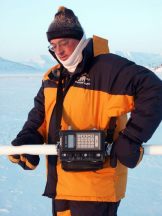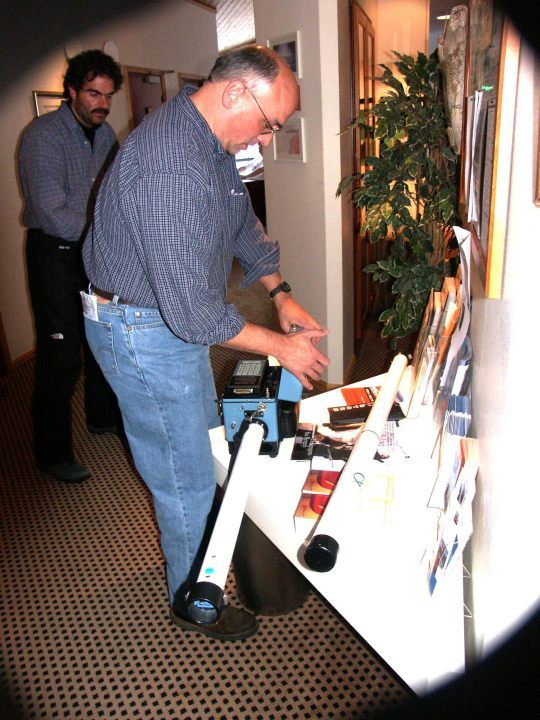 |
|
|
NASA EM-31 Ice Thickness Project.
North Pole Expedition 2003.
| North Pole Expedition 2003. |
|
|
| Home Base | ( North Pole 2002 ) | Acoustic Guitars | ( North Pole 2005 ) | Real Sports Cars for Sale |
| Airplane Models | Aircraft Calendars | ( Corvettes for Sale ) | Tanks | Museums |
| Jet Fighter Models | Camaros for Sale | Ship Models | Military Vehicles } | ( Exhibits ) |
|
|
.
Please Note: The background on this page is an aerial photo of the sea ice near the island of Svalbard, Norway.
|
|
|
|

Photo by C. Jeff Dyrek |
| Rhett Herman and Jim Prepare the EM-31 for
initial use in Longyearbyen. The Radisson hotel is warm and this
is where the initial equipment setup and primary operational test are made.
If it doesn't work here, it won't work on the ice.
The purpose of the EM-31 project is
to measure the thickness of the ice and compare the results to a satellite
to ensure the satellite accuracy.
I talked to Professor Herman and strongly requested that he immediately
show me the EM-31 and open it up so I could see inside. After about an
hour of talking, he did exactly that. We had a great time the rest of the
night working with the EM-31 on the ice of Longyearbyen Bay. I just want
to thank Professor Herman and the rest of his crew who stayed on the ice with me
all night, missing a night of sleep, just because I was so curious. It was
a great experience.
|
|
1-7-2008 Yes, I remember that time of trying to get things fixed so we could go back up quickly and get the data. Unfortunately things didn’t work out then. However they have worked out for other trips north after that. We’ve done more sophisticated measurements of the sea ice since then, but up in Barrow. The equipment that we now have is the next generation of electrical resistivity (OhmMapper) and now we have state-of-the-art ground penetrating radar. At some point it would be very interesting and useful to get this equipment to the pole and do a study that would be much more than we tried last time. Interesting history stuff you’ve found. It actually relates to something we’ve been doing here at Radford University. In July we took a research group to Guadalcanal to look for MIAs from the Guadalcanal invasion. We did not find anything this trip but we ruled out with certainly the presence of any burials in our survey area in July. We’re hoping to get back there this summer or the next to hit another, more likely (we now believe) area. I like the things you’ve brought together about the planes. From a physics standpoint I’m fascinated with the tech details of such things. I’ve been to the Air and Space museum a couple of times (in DC and at Udvar-Hazy) and it’s always fascinating to see the evolution of the aviation technology/engineering/materials/knowledge. Rhett
|
| . |
|
/North_Pole_2003/NASA-North_Pole_1.html|62539"
| . |